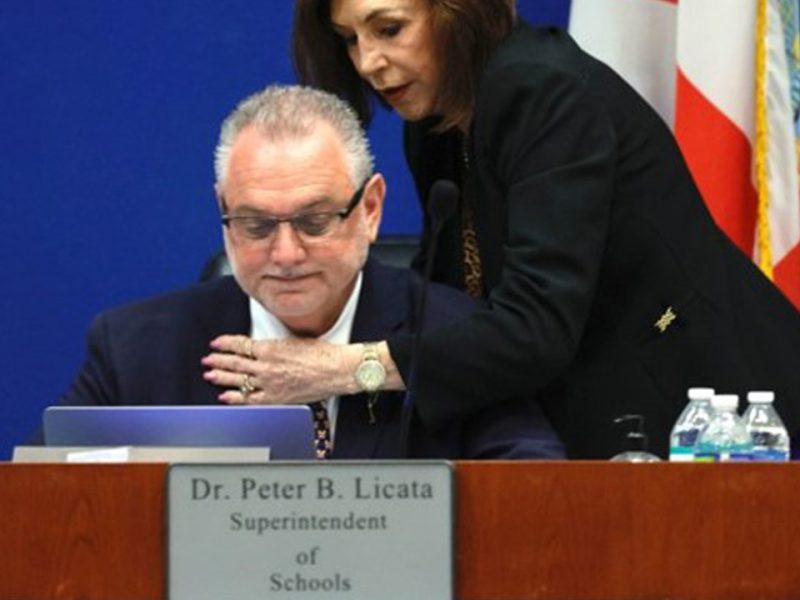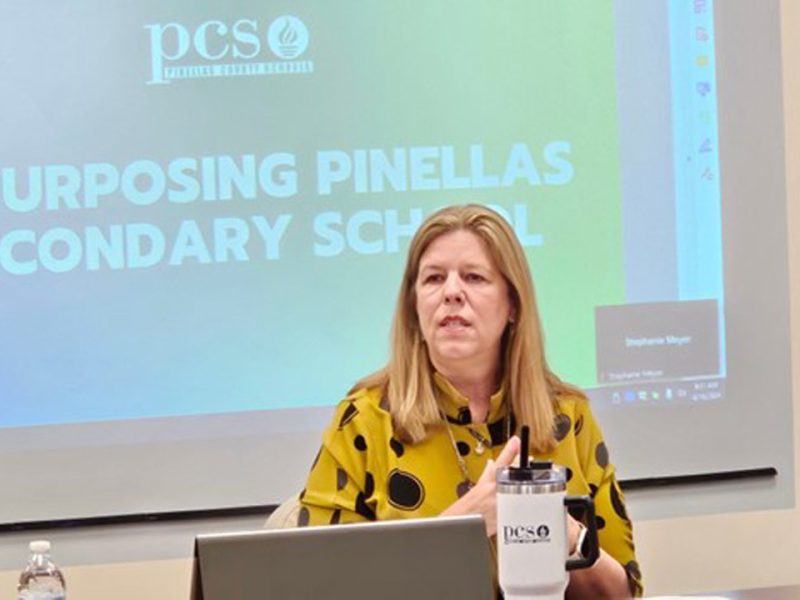The Already Dire Substitute Shortage Could Get ‘Worse Before It Gets Better’
Education Week | By Madeline Will | October 13, 2021
What happens when the teacher is out, and there’s no one available to lead the classroom? For many districts, that’s been a disconcerting reality this school year.
Substitute teachers have been in short supply in many school districts for years now. But this school year, the shortage has been dire. To fill the gaps, schools are tapping other staff members to cover classes, relaxing their requirements to substitute, and using their COVID-19 relief money to increase pay for subs. But even with these efforts, some districts have still had to cancel classes or even shut down schools due to the substitute shortage.
“Schools all across the country are scrambling to figure out what to do,” said Amanda von Moos, the co-founder of Substantial Classrooms, a national nonprofit focused on improving substitute teaching. And with cold and flu season and the holidays approaching, “I think we’re in for this getting worse before it gets better.”
A nationally representative survey, conducted by the EdWeek Research Center Sept. 29 to Oct. 8, found that 77 percent of principals and district leaders said they have struggled to hire a sufficient number of substitute teachers. More administrators pointed to difficulties hiring subs than any other staffing position.
Before the pandemic, the national average fill rate—meaning the percentage of teacher absences that was covered by a substitute—was about 80 percent. This year, von Moos said she’s hearing anecdotally that it’s closer to 50 or 60 percent.
Administrators and experts say the substitute shortage is caused by both high demand and low supply. In many places, teachers are out more frequently than usual because they’ve been exposed to or contracted COVID-19 and must quarantine, or because their own children have to quarantine. Also, school districts across the country are reporting starting the year with unfilled teaching positions. District leaders usually prioritize having substitutes cover those long-term absences, which means they’re now short on people to cover the short-term and medium-term absences.
The frequency of teachers being out for two weeks at a time due to quarantine requirements is unique to this year and creates logistical challenges, von Moos said. Often, the substitutes who are interested in longer-term jobs are already covering a teacher’s classroom. The available substitutes might not be able to work every day, which means districts will have to piece together a schedule for the two weeks, creating a “disjointed experience” for students, she said.
Also, there are fewer people willing to substitute this school year, administrators say. Many substitutes are retired teachers who may be at higher risk for serious COVID-19 complications. They may not feel comfortable returning to school buildings amid the ongoing pandemic. Some district leaders have said they’re having an especially hard time finding substitutes for elementary schools, since those students are all unvaccinated.
And private businesses are aggressively trying to incentivize and recruit workers—making the competition fierce. Substitute teaching has historically been a low-paid job with no benefits. Now, someone could feasibly make more money working at Starbucks.
Will the sub shortage hurt student learning?
While school districts are experiencing many different types of staffing shortages, the lack of reliable substitutes is hindering districts’ ability to catch students up academically. Experienced substitute teachers can mitigate the disruption in learning that comes with a teacher’s absence. Districts need that consistency more than ever, given the pandemic’s effect on student learning, but instead, they’re having to find alternative solutions.
In terms of finding substitutes, “last year was a difficult year, but it wasn’t so difficult so early,” said Michael Cummings, the superintendent of schools in Fairfield, Conn. Right now, the district is averaging a fill rate of about 60 to 70 percent—numbers that are typical right before the winter holidays or later in the spring. “I think one of our concerns [is that] it could get worse,” he said.
Principals are tapping teachers to give up their prep time to cover unfilled classes or are dispersing students throughout different classes. Infrequently, principals have had to cancel classes and offer a study hall instead, where students work on assignments without any direct instruction or support, Cummings said.
The EdWeek Research Center survey found that two-thirds of principals and district leaders across the country are asking their employees to take on additional responsibilities because of struggles with shortages.
To lessen the number of teacher absences, administrators are considering scaling back professional learning days, Cummings said.
Meanwhile, the San José Unified school district is having its counselors, intervention specialists, and other staff members be “on call” to substitute for four days every month. The decision was overwhelmingly unpopular among counselors and others in the community, said Crystal Calhoun, a grandmother to four students in the district and an elder leader of the San José Unified Equity Coalition, a grassroots group of educators, students, and community members fighting for racial equity.
“During this crisis that children have been through, they need more counselors and not less,” Calhoun said, adding that students are feeling more anxious and reporting more suicidal thoughts than in years past. “The best we can do for them is give them as much support and counseling as we can. … Counselors are calling me in tears about this decision.”
For Dana Fate, a middle school counselor in the district, the decision was disheartening. The district is placing counselors in any school, not necessarily the one they work in, so they may not have prior relationships with the students. Subbing will take away from the amount of time she has to address her students’ mental health needs, she said, and she doesn’t feel comfortable serving as a teacher.
“They’re asking us to do something we’re not qualified to do,” Fate said. “Kids are already coming back from a year and a half [of remote school]. We’re not going to be able to get them up to speed.”
Some districts have had to consider the worst-case scenario: temporarily shutting down schools. In Filer, Idaho, the substitute shortage—and high volume of staff absences due to COVID-19—forced the school district to cancel all classes and close for a week late last month.
“We needed some time to regroup,” said Superintendent Kelli Schroeder, adding that with such significant shortages, students were congregating in the school library or gym instead of being in class.
The small, rural district used to offer $65 a day for a substitute teacher without a bachelor’s degree and $80 a day for someone with a degree. This school year, the district increased the pay to $80 and $95 a day, respectively. But now, Schroeder said she’s going to propose that the school board use additional money from the state to increase pay rates even further, to $110 a day without a bachelor’s degree and $125 a day with one. This increase would be temporary through December, she said.
The shutdown publicized the district’s dire need for substitutes, so more people have since applied to work even just one day a week or a few days a month, Schroeder said: “We’ll take it.”
And a couple businesses in town, including the local internet provider, volunteered to have their employees pinch-hit during periods of particularly high absences. Schroeder said the district is set for now with the new applicants, but she may circle back to that offer if needed.
“The community has really stepped up in helping us with that problem,” Schroeder said. “I’m hoping we don’t have to [shut down] again—I’m hoping people stay healthy.”
More money isn’t always the solution
Before the pandemic, the Boulder Valley school district in Colorado had a pool of about 900 substitutes. This school year, it started off with about 300 substitutes. After weeks of actively recruiting subs—including parents—the district now has about 560 substitutes in its system, said Mike Gradoz, the assistant superintendent of human resources.
But Fridays have been the most challenging days to fill teacher absences. The district was only filling about two-thirds of its absences, Gradoz said. In late September, the district doubled its Friday pay rate from $100 to $200. Last week, the fill rate was 78 percent, Gradoz said.
“It’s starting to increase a little bit, but it’s not good enough,” he said, adding that when there aren’t enough substitutes, teachers often have to give up their prep period to cover classes, or principals or central office staff fill in. “It really contributes to lower morale.”
Still, Gradoz said he doesn’t know if further raising the pay will solve the problem. Other nearby districts pay about $20 more and have similar fill rates, he said. Improved working conditions may also help recruitment and retention among substitutes.
“We’re encouraging principals [to do] things to make them feel wanted and comfortable and welcome so they’ll come back,” he said. That includes incentives such as gift cards for coffee, provided lunch, and well-organized lesson plans. “If they have a sub, they’ll give them the red carpet.”
Indeed, Substantial’s von Moos said increasing pay is “desperately needed” but won’t be enough to solve this crisis: “I think we will need some kind of innovation.”
For example, Substantial, the nonprofit for reimagining substitute teaching, has long encouraged the model of full-time substitute teachers who are based in a single school. That approach can help to address disparities in coverage and provide more stability for students and staff. Gradoz said the Boulder Valley school district is considering implementing a similar model due to the persistent shortage this year.
States may relax requirements for substitutes
Von Moos, who recently co-authored a book about redesigning the substitute teaching experience, said she hopes that states will reconsider some of the hurdles to become a substitute this year, including by waiving application fees and streamlining the permit process. Some states are also considering relaxing education requirements, such as having a bachelor’s degree.
“We rely on a bachelor’s degree as a signal of perseverance and competence, and it doesn’t really match what we need people to be doing in these roles,” von Moos said. “People who are great working with kids may not have that degree. What we really need to focus on is, what are the skills and attributes that people need to be successful as a substitute teacher?”
For example, the state of Oregon had just about 4,700 licensed substitute teachers in mid-September—down from nearly 8,300 in December 2019, before the pandemic. In response to the staffing shortage, the Oregon Teacher Standards and Practice Commission has temporarily dropped the requirement for substitutes to have a bachelor’s degree.
“We thought long and hard about what it means to possibly have someone without a bachelor’s degree in a substitute position,” said Anthony Rosilez, the executive director of the commission, in an email. “That is why we established very strong responsibilities for the sponsoring district to guide and support the licensee in their work. Furthermore, we hope that the need for this unique license will only be temporary.”
However, the rule change has posed some unintended complications for districts, said Cathy Hurowitz, the superintendent of Clatskanie school district in northwest Oregon. Paraprofessionals who don’t have bachelor’s degree are now qualified to substitute—and the pay rate for substitutes is at least $10 an hour higher than it is for classified school staff. Those paraprofessionals could fill any teacher absences, but then the district would still have to fill their positions, and it was already experiencing a shortage of substitutes for instructional support staff, Hurowitz said.
“This is just a can of worms,” she said. “I know the department was trying to help, … [but] it creates a bigger problem.”
Still, Hurowitz said that since the state is allowing substitutes who don’t hold a college degree, she would rather those subs be the district’s own staff. The district plans to prioritize giving substitute licenses to staff members who are in a teacher education program, then staffers who holds credits toward a bachelor’s degree, and finally staffers who have an associate’s degree.
Ultimately, Hurowitz said, “we just need people.”






